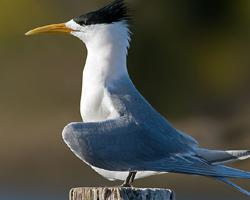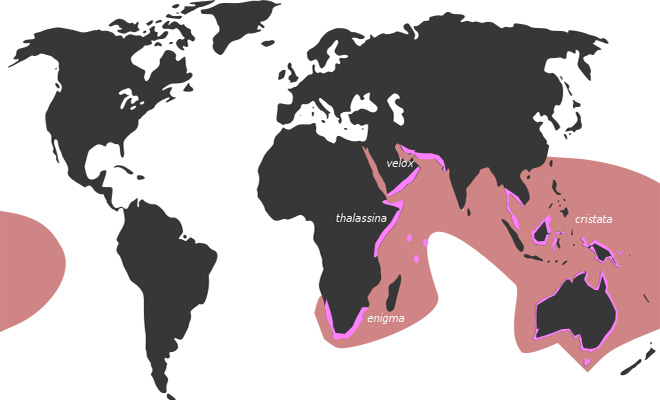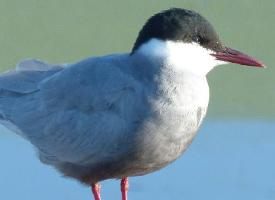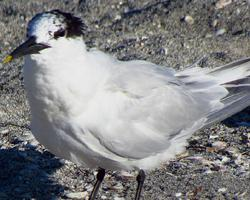
Starea de conservare
| Amenințat |
Descrierea animalului
The Greater Crested Tern (Thalasseus bergii), also known as the Swift Tern or the Crested Tern, is a seabird in the tern family that exhibits a striking blend of grace and power. This medium to large-sized tern is characterized by its robust build, sharp features, and distinctive plumage, making it a fascinating subject of study for ornithologists and birdwatchers alike.Adult Greater Crested Terns are easily recognizable by their sleek, predominantly light gray bodies, which contrast sharply with their black caps. During the breeding season, the black cap extends from the bill over the top of the head to the nape, culminating in a short, shaggy crest that gives the species its common name. The forehead becomes white, and a thin white line often separates the black cap from the bill, adding to their striking appearance. Their underparts are white, providing a stark contrast to the darker upperparts and wings. The long, sharp bill is yellow to orange-yellow, depending on the subspecies and geographic location, and their legs are black. The tail is forked, though less so than in many other tern species, and their flight is strong and direct, with powerful wingbeats that showcase their mastery of the air.
Juveniles and non-breeding adults exhibit a mottled appearance with a white forehead and a less defined crest, making them somewhat less conspicuous than their breeding counterparts. However, they retain the robust bill and overall body shape that are characteristic of the species.
Greater Crested Terns have a widespread distribution, found along coastlines and offshore islands in the Indian and Pacific Oceans, extending from South Africa eastwards to the Pacific islands and Australia. They are highly gregarious, often found in large, mixed-species flocks, especially outside the breeding season. Their habitats range from sandy beaches and rocky islands to estuaries and lagoons, where they can be seen diving into the water at high speeds to catch fish, their primary diet.
Breeding colonies of Greater Crested Terns are noisy and densely packed, with pairs forming strong bonds during the breeding season. They typically lay their eggs in simple scrapes in the sand or on bare rock, with both parents sharing the responsibilities of incubation and chick rearing. The sight of a colony with hundreds or even thousands of terns, interspersed with their raucous calls and aerial displays, is a spectacle to behold.
Conservation-wise, the Greater Crested Tern is considered to be of Least Concern by the International Union for Conservation of Nature (IUCN), thanks to its large range and apparently stable population. However, they are not without threats; habitat loss, human disturbance, pollution, and changes in fish populations due to overfishing and climate change are all potential concerns that could impact their numbers.
In conclusion, the Greater Crested Tern stands out as a resilient and adaptable seabird, embodying the wild beauty and dynamism of the world's oceans. Its presence along the coastlines serves as a reminder of the intricate web of life that depends on healthy marine ecosystems, and the importance of conserving these environments for future generations.
Harta răspândirii

Animale similare
Fotografii noi cu animale
Top 10 animale
- Diana monkey (Cercopithecus diana)
- Dolphin gull (Leucophaeus scoresbii)
- Galápagos tortoise (Geochelone nigra complex)
- Moustached guenon (Cercopithecus cephus)
- Japanese spider crab (Macrocheira kaempferi)
- Colossal squid (Mesonychoteuthis hamiltoni)
- Fox tapeworm (Echinococcus multilocularis)
- Stone loach (Barbatula barbatula)
- Japanese macaque (Macaca fuscata)
- Barbary macaque (Macaca sylvanus)


